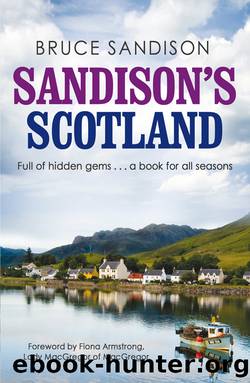Sandison's Scotland by Bruce Sandison

Author:Bruce Sandison
Language: eng
Format: epub
ISBN: 9781845025700
Publisher: Black & White Publishing
Published: 2012-11-27T00:00:00+00:00
25.
Highland Museum, Kingussie and Newtonmore
* * *
I looked at the ink-spattered paper on my desk and shuffled uncomfortably. It wasnât my fault. The steel nib of the wooden-shafted pen seemed to have a life of its own. Pupils behind me giggled at my discomfiture. The thumb and forefinger of my right hand were stained black. There was a spot of ink on my shirt. Mrs Brownlee loomed over me. âPlease, Miss, I didnât mean to do it, honest,â I pleaded.
âThatâs just not good enough, Bruce,â she said. âYou must try harder, otherwise you will have to pay the penalty.â Mrs Brownlee glared crossly and flexed the thick leather strap she was holding.
Thankfully, it was all âpretendâ. I was not a child again, only an adult visitor to the splendid Newtonmore Highland Folk Museum (HFM) schoolroom a few miles south from Inverness. But it had been a close-run thing because the reality of the experience had brought childhood memories flooding back. The classroom was an exact replica of the one where I had struggled in vain so many years ago with pen and ink at same unforgiving wooden desk. With the familiar hollow for holding the pencils I never remembered to bring to school and the same intimidating white ceramic inkwell.
Anna Brownlee is in fact a wonderful communicator, humorous and kindly, and with the sort of personality that brightens the dullest of days. The classroom once housed destitute Glasgow children whose fathers had been killed during the First World War. Its original location was near Kirkhill, north of Inverness, where it was intended to be temporary. The school closed in 1987 and HFM acquired the property, dismantled it and reconstructed it at Newtonmore. The walls are covered with 1930s maps. There is a ânature tableâ, blackboard, writing slates, games cupboard, childrenâs paintings on the walls, coat-hanging pegs and, dominating all, the teacherâs majestic desk.
The HFM Newtonmore site covers an area of eighty acres and is one and a half kilometres in length. Everything about this vibrant open-air museum inspires. The care, attention to detail and the meticulous planning and veracity of the exhibits demonstrates the highest standards of excellence. Clearly, this is a labour of love for those involved, from Ross Noble, the curator, and his staff, to each of his forty-strong, part-time team of helpers. Their most notable characteristics are unwavering courtesy and patience, fortified with a thorough knowledge of the exhibits they attend. From start to finish, everyone I met was welcoming.
The original museum, Am Fasgadh, âThe Shelterâ, was established in 1944 in Kingussie and was the inspirational dream of a remarkable woman, Dr Isabel Frances Grant (1887â1983). Dr Grant visited Scandinavia during the 1920s and was impressed by the importance placed there upon folk museums â museums that captured the culture of the people and how they lived and worked and played. Dr Grant was determined to replicate that philosophy in the Highlands of Scotland, initially by opening a museum on Iona in 1936 and then, when the collection outgrew the space available, by moving to Kingussie.
Download
This site does not store any files on its server. We only index and link to content provided by other sites. Please contact the content providers to delete copyright contents if any and email us, we'll remove relevant links or contents immediately.
Backpacker the Complete Guide to Backpacking by Backpacker Magazine(2213)
Capital in the Twenty-First Century by Thomas Piketty(1982)
The Isle of Mull by Terry Marsh(1919)
Predation ID Manual by Kurt Alt(1669)
The Collected Non-Fiction by George Orwell(1592)
Small-Bore Rifles by C. Rodney James(1518)
All Fishermen Are Liars by John Gierach(1464)
Backcountry Bear Basics by Dave Smith(1450)
Creative Confidence by Tom Kelley(1430)
The Art of Throwing by Amante P. Marinas Sr(1372)
50 Famous Firearms You've Got to Own by Rick Hacker(1355)
Blood Mountain by J.T. Warren(1316)
Archery: The Art of Repetition by Simon Needham(1315)
Long Distance Walking in Britain by Damian Hall(1291)
The Scouting Guide to Survival by The Boy Scouts of America(1270)
Backpacker Long Trails by Backpacker Magazine(1258)
The Fair Chase by Philip Dray(1240)
The Real Wolf by Ted B. Lyon & Will N. Graves(1223)
The Ultimate Guide to Home Butchering by Monte Burch(1216)
